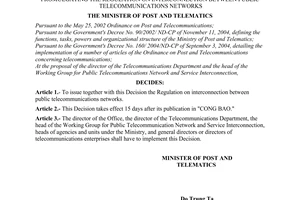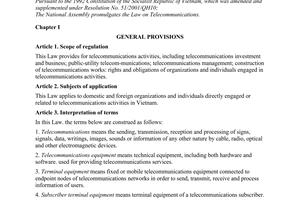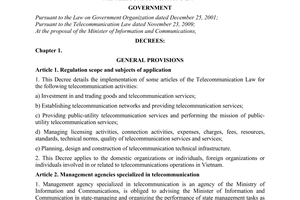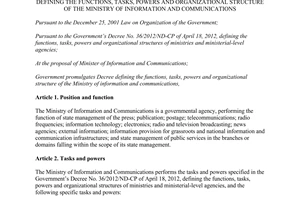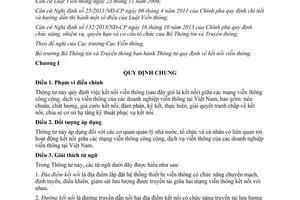Nội dung toàn văn Circular No. 07/2015/TT-BTTTT on telecommunications connectivity
|
THE MINISTRY
OF INFORMATION AND COMMUNICATIONS |
SOCIALIST
REPUBLIC OF VIETNAM |
|
No. 07/2015/TT-BTTTT |
Hanoi, March 24, 2015 |
CIRCULAR
ON TELECOMMUNICATIONS CONNECTIVITY
Pursuant to the Law on telecommunications dated November 23, 2009;
Pursuant to the Decree No. 25/2011/NĐ-CP dated April 06, 2011 by the Government providing instructions on the implementation of a number of articles of the Law on telecommunication;
Pursuant to the Decree No. 132/2013/NĐ-CP dated October 16, 2013 by the Government defining the functions, tasks, entitlements and organizational structure of the Ministry of Information and Communications;
At the request of the Director of the Vietnam Telecommunications Authority,
The Minister of Information and Communications promulgates the Circular on telecommunications connectivity.
Chapter I
GENERAL PROVISIONS
Article 1. Scope of regulation
This Circular provides for telecommunications interconnection (hereinafter referred to as interconnection) among public telecommunications networks, telecommunications services of telecommunications enterprises in Vietnam, including: standard, quality and charge of interconnection; negotiation, contracting, execution of interconnection and settlement of disputes about interconnection; sharing technical infrastructure for the interconnecting activities.
Article 2. Regulated entities
This Circular applies to State management agencies, organizations and individuals relating to the interconnecting activities among public telecommunications networks, telecommunications services of telecommunications enterprises in Vietnam.
Article 3. Interpretation of terms
In this Circular, these terms can be construed as follows:
1. Place of connection means where a system of telecommunications devices is located for circuit switching, routing, controlling, monitoring data traffic between two connected telecommunications networks.
2. Connecting line means a cable connecting 2 places of connection, functioning for transmitting data between two connected telecommunications networks. Connecting capacity means capacity of the connecting line.
3. Connecting device means a device located at a place of connectivity for transmitting data between two connected telecommunications networks.
4. Points of interconnection (POI) mean a point lying on the connecting line that functions as a boundary defining the economic and technical responsibilities between two telecommunications networks joining the interconnection system.
5. Interconnection providing enterprise means a telecommunications enterprise that is requested by another telecommunications enterprise to provide interconnection.
6. Interconnection requesting enterprise means a telecommunications enterprise that requests another telecommunications enterprise to provide interconnection.
7. Interconnection agreement means an agreement of economy and technique between telecommunications enterprises serving the interconnection among public telecommunications networks, telecommunications services.
Chapter II
ECONOMIC AND TECHNICAL REGULATIONS ON CONNECTIVITY
Article 4. Place of connectivity
1. Place of connection is decided by enterprises participating in interconnection system (hereinafter referred to as participating enterprises) via a deal by choosing any connectivity place on telecommunications network feasible in the following technique:
a) Public Switched Telephone Connectivity (PSTN): host/tandem, Toll, international gateway;
b) Public Land Mobile Network (PLMN): Mobile Switching Center (MSC/SGSN); Network Switching Subsystem (GMSC/GGSN);
c) Next Generation Networking (NGN);
d) Domestic/long-distance/international transmission centers;
dd) Other connecting place decided by participating enterprises without any violations against the regulations on connection in Articles 42 and 43 of the Law on telecommunications and this Circular.
2. Quantity, cost and mode of setting up place of connection are decided by participating enterprise without any violations against the regulations on connectivity in Articles 42 and 43 of the Law on telecommunications and this Circular.
3. If the agreement on place of connection of telecommunications enterprises against the rules of ensuring the sustainable development of telecommunications market; telecommunications infrastructure safety, information security, lawful rights and benefits of the telecommunications service users, then Vietnam Telecommunications Authority will request the enterprises to re-negotiate.
4. In case telecommunications enterprises fail to negotiate an agreement, Vietnam Telecommunications Authority will decide the place of connection.
Article 5. Shared use of connecting place
1. Shared use of connecting place is when telecommunications enterprises negotiate and reach an agreement on location, conditions for fitting up connecting devices, auxiliary devices serving the connectivity (power supply, air-conditioner, etc) at the place of connection and specific location of the connecting point.
2. Shared use of connecting place:
a) Shared use of real point of interconnection: interconnection requesting enterprises are responsible for the initial install of cables used for interconnection; interconnection providing enterprises shall arrange a premise for installing interconnecting devices, auxiliary devices serving the interconnection (power supply, air-conditioner, etc) and other essential conditions (for operating and maintaining devices, etc) at their own place of interconnection.
In this case, connecting point will be on a distribution frame (DDF, ODF or MDF) at the point of interconnection of the interconnection providing enterprises determined by participating enterprises;
b) Shared use of virtual interconnection point: participating enterprises ensure themselves places to fit up their own connecting devices; negotiate an agreement on building up connecting line and pay the cost for their own installing, operating, maintaining connecting devices.
For this case, place of interconnection is a point on the connecting line decided by participated enterprises.
3. Except for case of other regulations of laws or other agreements among participated enterprises, the principle of using the same point of interconnection at satisfactory places shall be applied to improve the quality, reduce interconnection cost and facilitates enterprises to join the interconnection system.
Article 6. Criteria and quality of connectivity
1. Criteria for interface, signals, counters of the connecting devices:
a) Connecting interface is decided according to the agreement among participated enterprises on the basis of satisfying relevant technical standard and compulsory criteria required by the Ministry of Information and Communications;
b) Unless there is an agreement among telecommunications enterprises, signals between telecommunications networks participating in the interconnection are to be the signal system No. 7 on the basis of following the relevant technical standard and the compulsory criteria established by the Ministry of Information and Communications;
c) Network of interconnection requesting enterprises may pick up synchronous signal directly from model counter of interconnection providing enterprises to synchronize there own networks or according to the counters that are provided through the telecommunications devices of the interconnection providing enterprises at the point of interconnection using the master-slave model. Synchronous counter shall be conformable to relevant technical standards and the compulsory criteria promulgated by the Ministry of Information and Communications.
2. Quality of connection:
a) Network congestion is determined according to the criteria prescribed in Appendix 01 enclosed herewith;
b) The effectiveness in the use of interconnection is determined according to the criteria prescribed in Appendix 02 enclosed herewith;
c)� Total connection capacity is determined according to the criteria prescribed in Appendix 03 enclosed herewith.
Article 7. Interconnection charges
1. Interconnection charges is based on the market price and calculated according to the components of the network or according to the part of service directly relating to the interconnection of telecommunications networks and the State policies on telecommunications market, telecommunications services by period.
2. Based on the real conditions in each period, the Ministry of Information and Communications shall promulgate interconnection charges for telecommunications network of each telecommunications enterprises or groups of telecommunications enterprises (group of dominant enterprises, group of other enterprises, etc) according to the interconnection charges of each enterprise or average interconnection charge of the group of enterprises.
3. Pursuant to the request and regulations of the Ministry of Information and Communications, telecommunications enterprises shall create the interconnection cost and propose interconnection charge then report them to the Ministry of Information and Communications for consideration and decision.
4. Enterprises participating in interconnection shall set up a technical system to record compare and examine figures for the payment of interconnection charge.
5. Based on the real operating condition of each service of each enterprise, enterprises participating in interconnection negotiate on the time of comparing and examining figures and paying interconnection charge. Unless there is another agreement, enterprises shall carry out the comparison and examination on the figures and pay the charge for interconnection every month.
Chapter III
NEGOTIATION, CONTRACTING AND EXECUTION OF AGREEMENT ON INTERCONNECTION
Article 8. Application for model connectivity agreement
1. Within 30 working days from the day on which a telecommunications enterprise is determined to be the one holding the essential instruments, such enterprise shall prepare, submit directly or by post to the Vietnam Telecommunications Authority an application for model connection agreement. Telecommunications enterprises other than those holding the essential instruments may draw up and promulgate model connectivity agreement without registration to the Vietnam Telecommunications Authority on the basis of conformity with the provisions in this Circular for consistent application with telecommunications enterprises.
2. Application for model connectivity Agreement shall include:
a) An application form for model connectivity Agreement containing seal and signature of the representative according to the regulations using form in Appendix 04 enclosed herewith;
b) Model connectivity Agreement;
c) Economic and technical documents relating to the contents of model connectivity agreement (if any).
3. Model connectivity agreement shall include at least the contents specified in clause 2 Article 13 of this Circular.
Article 9. Approval for model connection agreement
1. Within 20 working days from the day on which the sufficient and conformable application is received, Vietnam Telecommunications Authority is responsible or considering and making written notification of whether the model connectivity agreement is approved or not (if the agreement is rejected, their shall be explanation).
2. The Vietnam Telecommunications Authority will reject the model connectivity agreement if:
a) Such model connectivity agreement is against the regulations on economy and technique specified in Articles 4, 5, 6 and 7 of this Circular, the regulations on telecommunications and other relevant legal regulation;
b) Such model connectivity agreement includes contents that affect to lawful rights and interests of other telecommunications enterprises or telecommunications service users.
3. When the written approval of the Vietnam Telecommunications Authority for model connectivity agreement is received, telecommunications enterprises holding essential instruments shall promulgate and publish the model connectivity agreement for consistent application with interconnection requesting enterprises.
Article 10. Modification of model connectivity agreement
If a telecommunications enterprise holding essential instruments wishes to modify the model connectivity agreement, such enterprise shall perform the registration like the initial registration according to the provisions in Articles 8 and 9 of this Circular.
Article 11. Application for connectivity
Any enterprise applying for connectivity shall send a written application to connectivity provider. The application for connectivity shall include at least the following information:
1. Time and location of the connectivity negotiation.
2. Type of network and connectivity service.
3. Feasible place of connectivity on the network.
4. Shared use of connectivity place.
5. Technical regulations and standards of connecting devices; connecting interface; signal, counter in connectivity, etc.
6. Minimum connection capacity for the next 12 months.
7. Connection quality norms (network congestion, effectiveness of connection, etc).
8. Method, time limit for comparing, examining and paying connection charge.
9. Sharing of infrastructure serving the connectivity.
10. Connecting information.
11. Other information (if any).
Article 12. Response to application for connectivity
Within 07 working days from the day on which the sufficient and conformable application is received, the connectivity provider shall make a written response contain the approval for negotiation of Agreement of connectivity (indicating time, location of negotiation of the interconnection agreement). If the application is rejected, there shall be explanation.
Article 13. Negotiation and contracting the interconnection agreement
1. Within 07 working days from the day on which the interconnection requesting enterprise receives written approval for negotiation on interconnection agreement, the interconnection parties shall conduct the negotiation of interconnection agreement.
2. The negotiation of connectivity agreement shall include at least the following information:
a) Requirements and principles of connection;
b) Procedures for connection;
c) Type of network and connection service;
d) Feasible place of connection on the network;
dd) Shared use of connecting place;
e) Capacity of connection;
g) Technical regulations and standards of connecting devices, connecting interface, signals, counter, etc.
h) Connection quality norms (network congestion, effectiveness of connection, etc);
i) Method, time limit for comparing, examining and paying connection charge;
k) Procedures for modification of connection services, connection capacity;
l) Measures for infrastructure safety and information security in connectivity;
m) Procedures for settling arisen problems and restoring information;
n) Sharing infrastructure serving the connectivity;
o) Settlement of disputes, indemnity, complaints in connectivity process;
p) Rights and obligations of the parties in connectivity process;
q) Connecting information.
3. For telecommunications enterprises holding essential instruments, connectivity agreement with other enterprises shall be drawn up and negotiated on the basis of the connection agreement approved by the Vietnam Telecommunications Authority.
4. Unless there is another agreement, within 30 working days from the day on which the negotiation of connection agreement is conducted, the parties shall finish the negotiation and contract the connection agreement.
Article 14. Negotiation and contracting the connection capacity supply
1. Within 7 working days from the day on which the connectivity agreement is signed, based on the signed agreement, the party enterprises shall conduct the negotiation and sign the connection capacity supply contract according to the regulations on contracts.
2. Unless there is another agreement, within 30 working days from the day on which the negotiation of connection capacity supply agreement is conducted, the parties shall finish the negotiation and contract the connection capacity supply agreement.
Article 15. Connection
Unless there is another agreement, within 15 working days from the day on which the negotiation of connection capacity supply agreement is conducted, the parties shall perform sufficiently and punctually the contents of connectivity agreement and the signed connection capacity supply contract.
Article 16. The change in connection capacity
1. If a connection capacity requesting enterprise wish to increase or decrease connection capacity to ensure the connection quality, such enterprise shall send a written application to relevant telecommunications enterprises. The application shall include at least the following information:
a) Reason for the increase/decrease;
b) Figures proving the necessary for such increase/decrease;
c) The amount of capacity subject to increase/decrease;
d) Time of increase/decrease.
2. Within 07 working days from the day on which the application for modification of connection capacity is received, the telecommunications enterprise receiving the application shall make a written response containing whether it is approved or not (if the application is rejected, there shall be explanation).
3. Except for otherwise agreed cases, within 15 working days from the day on which the application for modification of connection capacity is approved, the party enterprises shall modify the connection capacity according to the agreement.
Article 17. Reporting on the interconnection
1. Periodically before January 31 of the year or irregularly (on request), telecommunications enterprises shall submit online or submit by post to the Vietnam Telecommunications Authority a written report on the interconnection in the previous year using the form in Appendix 05 enclosed with this Circular.
2. Telecommunications enterprises shall be responsible for the accuracy and promptness of the report.
3. In necessary case, at the request of the Vietnam Telecommunications Authority, telecommunications enterprises are responsible for:
a) Proving the accuracy of the report;
b) Appointing experts to cooperate and provide necessary equipment for the Vietnam Telecommunications Authority to examine the accuracy of their report.
Chapter IV
Sharing technical infrastructure for interconnection
Article 18. Rule of sharing technical infrastructure for interconnection
1. Sharing technical infrastructure for the interconnection is the shared use of a part of telecommunications networks, works or devices between party enterprises in order to reduce the expense and increase the connection quality.
2. To ensure that the interconnection is effective, smooth and quick, telecommunications enterprises shall share the following technical infrastructure:
a) Technical infrastructural constructions (drains, tanks, trenches and tunnel, cable post, antenna post, etc)
b) Stations and auxiliary equipment serving interconnections (power, air-conditioner, distribution frame, cable trays, etc.) within the venue connections.
3. The sharing of infrastructure to serve the interconnection is performed through the concluding of contract of leasing technical infrastructure serving the connection between the parties on the basis of ensuring the equality, reasonableness and the conformity with the provision about connection in the Law on telecommunications.
4. Telecommunications enterprises sharing technical infrastructure are responsible for enabling other telecommunications enterprises to:
a) Lease technical infrastructures specified in clause 2 of this Article and ensure the necessary conditions for the connection;
b) Fit up, operate, maintain, repair devices at the point of interconnection.
5. Telecommunications enterprises receiving technical infrastructure share shall:
a) Comply with the regulation on safety, security of telecommunications enterprises sharing technical infrastructure;
b) Notify to telecommunications enterprises sharing technical infrastructure of the plans on installing, operating, maintaining, repairing interconnection devices in the scope of place of interconnection before carrying.
c) Pay the leasing charge of technical infrastructure serving the interconnection according to the contract.
Article 19. Leasing charge of technical infrastructure serving interconnection
1. Leasing cost of technical infrastructure serving interconnection shall be based on the market price according to the regulation on price and on telecommunication.
2. Telecommunications enterprises shall conduct a negotiation on leasing cost of technical infrastructure serving interconnection.
Article 20. Signing the contract on leasing technical infrastructure serving interconnection
1. Unless there is another agreement, the lease of technical infrastructure serving interconnection is a part of the contract for connection capacity supply.
2. If the lease of technical infrastructure serving the interconnection is perform in a separate contract, then the negotiation and signing the contract for leasing technical infrastructure serving interconnection is performed concurrently with the negotiation and signing the contract for connection capacity supply.
Chapter V
SETTLEMENT OF DISPUTE IN CONNECTION
Article 21. Disputes in telecommunications connection
Disputes in telecommunications connection includes:
1. Disputes about connection agreement.
2. Disputes about connection capacity supply.
3. Disputes about sharing infrastructure for the interconnection.
4. Other disputes during the telecommunications connection.
Article 22. Procedures for settling disputes
1. Telecommunications enterprises applying for dispute settlement are responsible for submitting directly or by post 1 application to the Vietnam Telecommunications Authority.
2. Application for dispute settlement shall include at least:
a) An application form for dispute settlement containing seal and signature of the legal representative of telecommunications enterprises using form in Appendix 06 enclosed herewith;
b) Relevant evidences and documents (if any).
3. Vietnam Telecommunications Authority is responsible for examining, collecting relevant information and evidence. The parties are responsible for providing sufficiently information and evidence at the request of Vietnam Telecommunications Authority.
4. Within 30 working days from the day on which the satisfactory application for dispute settlement is received, Vietnam Telecommunications Authority shall conduct a negotiation among the relevant parties. There shall be a record of the result of the negotiation containing signature of legal representatives of the party members of the negotiation and the Vietnam Telecommunications Authority.
5. After the negotiation process, if the relevant party members can reach an agreement on the disputed content, the dispute will be settled according to the agreement. If the relevant party members can reach an agreement on the disputed content, within 15 working days from the day on which the negotiation is signed, Vietnam Telecommunications Authority shall make decision for settling the dispute.
6. During the settlement of disputes, the Vietnam Telecommunications Authority may consider and request the parties to ensure the interconnection conformable with the conditions before dispute arise or offer another solution to ensure the interconnection, in case:
a) To ensure public benefits or the integrity of the telecommunications network;
b) The dispute affects the business of other telecommunications enterprises;
c) To ensure benefits of telecommunications service users, ensure the accessibility of telecommunications service users to emergency calls;
d) To ensure the public telecommunications service;
dd) Other cases according to the regulations of the Ministry of Information and Communications.
7. Enterprises in dispute are responsible for immediately implementing the decision on settlement of dispute of the Vietnam Telecommunications Authority even the case of disagreement with the decision and have a right to lodge complaints according to the provisions of laws.
Chapter VI
IMPLEMENTATION
Article 23. Effect and organization of implementation
1. This Circular comes into effect from May 10, 2015.
2. This Circular replaces the Decision No. 547/1998/QĐ-TCBĐ dated September 03, 1998 by the Directorate General of Posts and telecommunications and the Decision No. 12/2006/QĐ-BBCVT dated April 26, 2006 by the Ministry of Posts and Telecommunications.
3. The Chief officers, the Chief Inspector, the Director of the Vietnam Telecommunications Authority, Heads of agencies, units affiliated to Ministries; General Director, Directors of telecommunications enterprises and relevant organizations and individuals are responsible for implementing this Circular.
4. Difficulties that arise during the implementation of this Circular should be reported to the Ministry of Information and Communications for consideration and resolution./.
|
|
THE MINISTER |
------------------------------------------------------------------------------------------------------
This translation is made by LawSoft and
for reference purposes only. Its copyright is owned by LawSoft
and protected under Clause 2, Article 14 of the Law on Intellectual Property.Your comments are always welcomed
